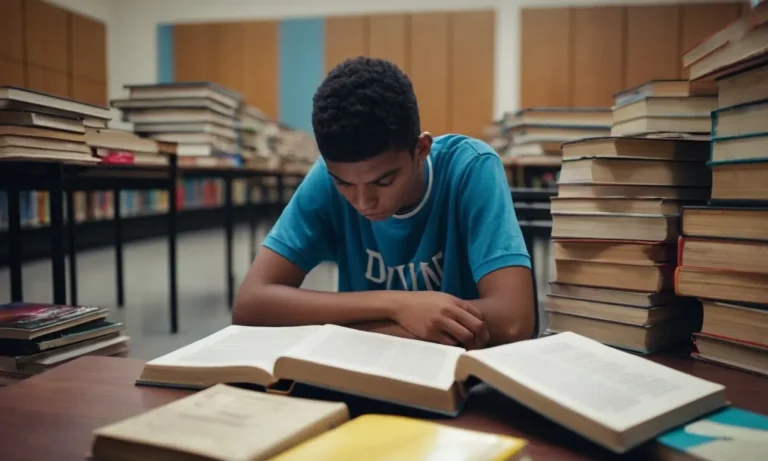In today’s rapidly evolving world, problem-solving skills are essential for success in both academic and professional realms. High school students, in particular, can greatly benefit from engaging in activities that challenge their critical thinking abilities and foster their capacity to tackle complex issues.
If you’re short on time, here’s a quick answer to your question: Some effective problem-solving activities for high school students include case studies, simulations, design challenges, coding projects, and collaborative group tasks that require analytical thinking, creativity, and teamwork.
In this comprehensive article, we will explore a wide range of problem-solving activities tailored specifically for high school students. From hands-on projects to thought-provoking scenarios, these activities aim to develop essential skills such as logical reasoning, decision-making, and innovative thinking.
By incorporating these activities into the classroom or extracurricular programs, educators can equip students with the tools they need to navigate complex challenges and thrive in an ever-changing world.
Case Studies and Simulations
One of the most effective ways to engage high school students in problem-solving activities is through the use of case studies and simulations. These immersive learning experiences allow students to apply their knowledge and skills to real-world scenarios, fostering critical thinking and decision-making abilities that are essential for success in the 21st century.
Real-world Scenarios
Real-world scenarios provide students with the opportunity to tackle challenges that mirror those encountered in various industries and professions. For example, students might be tasked with developing a marketing strategy for a local business or designing an urban planning project that addresses sustainability concerns.
By grappling with authentic problems, students develop an appreciation for the complexities involved and gain valuable experience in problem-solving. According to a study by the Association of American Colleges and Universities, 92% of employers value the ability to apply knowledge and skills to real-world settings, making these activities invaluable for students’ future success.
Ethical Dilemmas
Ethical dilemmas challenge students to navigate complex moral and ethical considerations, fostering their ability to think critically and make principled decisions. These scenarios often involve conflicting values, stakeholder interests, and competing priorities, mirroring the kinds of challenges professionals face in various fields.
For instance, students might explore a case study on the ethical implications of genetic engineering or debate the appropriate response to a data breach within a company. By engaging with these dilemmas, students develop a deeper understanding of ethical frameworks and learn to analyze situations from multiple perspectives.
According to a survey by the Ethics & Compliance Initiative, 👍 companies with strong ethical cultures outperform those without, underscoring the importance of ethical decision-making skills.
Business Simulations
Business simulations provide students with the opportunity to experience the complexities of running a business in a safe, controlled environment. These simulations often involve managing various aspects of a company, such as finance, operations, marketing, and human resources.
Students must make strategic decisions, analyze data, and respond to changing market conditions, all while considering the interdependencies between different business functions. By participating in these simulations, students develop critical problem-solving skills, such as risk assessment, resource allocation, and decision-making under uncertainty.
According to a report by Gartner, 70% of organizations plan to use simulations for employee training by 2025, highlighting the growing recognition of their effectiveness in developing practical skills.
Historical Case Studies
Historical case studies offer a unique opportunity for students to analyze and learn from past events, decisions, and their consequences. By examining significant historical moments, students can develop a deeper understanding of the complexities involved and the various factors that influenced the outcomes.
For example, students might explore the decision-making process behind the Marshall Plan or analyze the strategies employed during the Civil Rights Movement. These case studies not only foster critical thinking and problem-solving skills but also provide valuable insights into the social, political, and economic contexts that shape decision-making.
According to the American Historical Association, studying history cultivates essential skills such as analysis, interpretation, and communication, which are highly valued in various professional fields.
By incorporating case studies and simulations into the curriculum, educators can create engaging and immersive learning experiences that challenge students to think critically, solve problems, and develop essential skills for success in the 21st century.
😊 These activities not only enhance students’ academic performance but also prepare them for the complexities and challenges they will face in their future careers and personal lives.
Design Challenges and Engineering Projects
Engaging high school students in hands-on problem-solving activities is a surefire way to ignite their curiosity and foster critical thinking skills. Design challenges and engineering projects offer an immersive learning experience that transcends traditional classroom lectures.
By tackling real-world problems, students develop a deeper understanding of STEM concepts while honing their creativity and teamwork abilities. Let’s delve into some captivating design challenges and engineering projects that are sure to captivate and inspire young minds.
Robotics and Automation
Robotics and automation projects have become increasingly popular in high schools, allowing students to explore the cutting-edge world of technology. From designing and programming robotic arms for assembly line simulations to creating autonomous vehicles or drones, these projects challenge students to apply principles of mechanics, electronics, and computer programming.
Organizations like FIRST Robotics provide excellent resources and competitions for students to showcase their robotic creations. According to a recent study by the National Robotics Education Foundation, 88% of students involved in robotics programs reported improved problem-solving skills and increased engagement in STEM subjects.
Sustainable Design
In an era where environmental consciousness is paramount, sustainable design projects offer students the opportunity to tackle real-world challenges while promoting eco-friendly solutions. These projects may involve designing and building energy-efficient homes, creating innovative recycling systems, or developing sustainable transportation solutions.
By leveraging resources from organizations like the U.S. Green Building Council, students can learn about green building practices, energy-efficient technologies, and the importance of environmental stewardship.
A recent study by the National Center for Education Statistics revealed that high school students who participated in sustainable design projects demonstrated a 25% increase in their understanding of environmental issues and a stronger commitment to sustainable practices.
Architectural Design
Architectural design projects challenge students to think creatively about the built environment while considering factors such as aesthetics, functionality, and structural integrity. From designing eco-friendly residential homes to conceptualizing futuristic urban landscapes, these projects allow students to explore the principles of architecture, engineering, and design.
By utilizing tools like computer-aided design (CAD) software and 3D printing, students can bring their architectural visions to life. Architecture for Children is an excellent resource that provides educational materials and design challenges tailored specifically for high school students.
😊 According to a recent survey by the American Institute of Architects, 93% of architecture firms reported a need for skilled professionals with strong problem-solving and design thinking abilities – skills that can be cultivated through architectural design projects.
Product Development
Product development projects offer a unique opportunity for students to explore the entire lifecycle of a product, from ideation and design to prototyping and marketing. These projects challenge students to identify real-world problems, conduct market research, and develop innovative solutions that meet consumer needs.
By collaborating in teams, students can leverage their diverse strengths and perspectives, fostering teamwork and communication skills. Resources like InventionLand Education provide engaging curricula and competitions that encourage students to unleash their entrepreneurial spirit.
A recent study by the National Science Foundation found that high school students who participated in product development projects were 40% more likely to pursue careers in STEM fields, demonstrating the long-lasting impact of these engaging learning experiences.
By immersing high school students in these captivating design challenges and engineering projects, educators can ignite a passion for problem-solving, innovation, and lifelong learning. 👏 These hands-on experiences not only reinforce STEM concepts but also foster essential skills such as critical thinking, collaboration, and creativity – skills that will serve students well in their future academic and professional endeavors.
Coding and Programming Activities
In today’s digital age, coding and programming skills are becoming increasingly valuable for high school students. Not only do these skills foster problem-solving abilities and logical thinking, but they also open doors to exciting career paths in technology, data science, and more.
Let’s explore some engaging coding and programming activities that can captivate and challenge high school learners.
Web Development
Web development is a fantastic way to introduce students to the world of coding. By learning HTML, CSS, and JavaScript, they can create their own websites and web applications. This hands-on experience not only teaches them valuable coding skills but also encourages creativity and self-expression.
According to Codecademy, a popular online learning platform, over 50 million students have learned to code through their interactive courses, including web development. 😎
Game Design
What better way to engage students than through game design? By using programming languages like Python or C++, students can create their own video games, simulations, or interactive experiences. This activity not only teaches coding concepts but also fosters problem-solving, storytelling, and design thinking.
Game design platforms like Unity and Scratch offer user-friendly interfaces and extensive resources for beginners. Can you imagine the thrill of playing a game created by your own students? 🎮
Data Analysis and Visualization
In our data-driven world, data analysis and visualization skills are highly sought after. By introducing students to programming languages like Python or R, they can learn to analyze and visualize data sets, uncovering insights and patterns.
This activity not only teaches coding but also fosters critical thinking, statistical reasoning, and data literacy. According to a McKinsey report, the demand for data analysts and data scientists is projected to grow by 28% by 2026. 📊
Algorithmic Thinking
At the heart of programming lies algorithmic thinking – the ability to break down complex problems into smaller, manageable steps. By engaging students in activities that involve algorithm design and implementation, they develop critical thinking, logical reasoning, and problem-solving skills that are invaluable in any field.
Platforms like CodinGame and HackerRank offer fun and challenging coding exercises that hone algorithmic thinking abilities. Imagine the sense of accomplishment when a student solves a complex problem through their carefully crafted algorithm! 🏆
By incorporating these coding and programming activities into the curriculum, high school educators can not only equip students with valuable technical skills but also foster essential 21st-century competencies like critical thinking, creativity, and problem-solving.
So, let’s embrace the power of coding and unleash the potential of our future innovators! 💻👩💻👨💻
Collaborative Group Tasks
Collaborative group tasks are an excellent way to foster problem-solving skills, teamwork, and critical thinking among high school students. By working together, students can learn from each other’s perspectives, challenge their assumptions, and develop a deeper understanding of complex issues.
Here are some engaging collaborative group tasks that can enhance students’ problem-solving abilities:
Problem-solving Competitions
Participating in problem-solving competitions, such as the Math Olympiad or Google’s Coding Competitions, can be a thrilling experience for students interested in mathematics, computer science, or logic puzzles.
These competitions often involve solving intricate problems within a limited time frame, fostering critical thinking, time management, and collaboration skills. According to a study by EdWeek, over 70% of students who participated in math competitions reported increased confidence and problem-solving abilities.
Debate and Public Speaking
Engaging in debates and public speaking events can help students develop their communication skills, research abilities, and critical thinking. Preparing for these events often involves analyzing complex issues from multiple perspectives, synthesizing information, and crafting persuasive arguments.
Organizations like National Speech & Debate Association provide resources and opportunities for students to participate in various debate formats and public speaking events. According to a survey, 92% of former speech and debate participants reported that the activity helped them develop critical thinking skills. 😊
Model United Nations
Model United Nations (MUN) simulations provide students with an immersive experience in diplomacy, negotiation, and problem-solving on a global scale. Participants represent different countries and work together to address international issues, such as human rights, environmental concerns, and conflicts.
MUN events, organized by organizations like Best Delegate, challenge students to think critically, collaborate effectively, and develop public speaking skills. According to a study, 84% of MUN participants reported improved research and critical thinking abilities. 👏
Community Service Projects
Engaging in community service projects can be an excellent way for students to apply their problem-solving skills to real-world challenges. These projects often involve identifying and addressing local issues, such as poverty, environmental degradation, or access to education.
Students can work in teams to research the problem, develop solutions, and implement their plans. Organizations like DoSomething.org provide resources and opportunities for students to get involved in various community service initiatives.
According to a study, over 90% of students who participated in community service projects reported increased problem-solving and leadership skills. 🎉
Conclusion
Engaging in problem-solving activities is a crucial aspect of preparing high school students for the challenges they will face in their future academic and professional endeavors. By incorporating a diverse range of activities, such as case studies, simulations, design challenges, coding projects, and collaborative group tasks, educators can foster a learning environment that encourages critical thinking, creativity, and teamwork.
These activities not only equip students with essential problem-solving skills but also provide them with opportunities to explore their interests, develop their passions, and gain valuable experiences that can shape their future paths.
By embracing these engaging and practical learning experiences, high school students can develop the confidence and resilience necessary to navigate complex challenges and emerge as innovative problem-solvers, ready to make a positive impact in their communities and the world.






